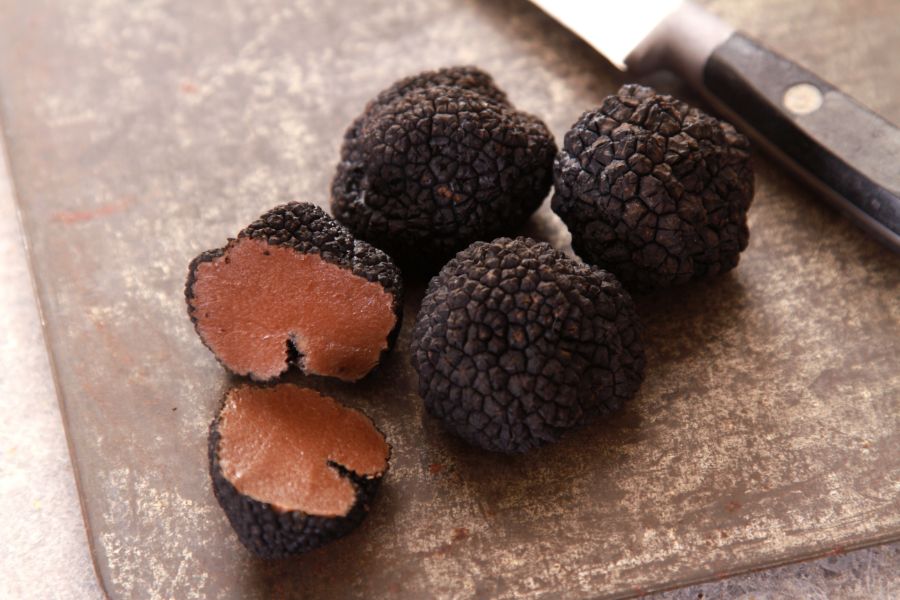Some of the most prized truffles come from European forests, but not all truffles are imported. A surprising number of native truffle species grow across the United States, including several that appear in North Carolina. These include both edible varieties and others that are still being studied.
It takes a keen eye and knowledge of the land to know where to look. You need the right mix of soil, tree cover, and elevation, and even then, truffles stay hidden underground.
These fungi don’t give away their location easily. The key is knowing what signs to look for and how to narrow your search. North Carolina’s truffles are out there, but they’re waiting for the right person to find them.
What We Cover In This Article:
- What Wild Truffles Look Like
- Truffle Lookalikes To Avoid
- Best Practices For Finding Truffles
- Where You Can Find Truffles Around The State
- Other Great Locations For Truffles
- When The Best Time Of The Year Is To Find Truffles
- The extensive local experience and understanding of our team
- Input from multiple local foragers and foraging groups
- The accessibility of the various locations
- Safety and potential hazards when collecting
- Private and public locations
- A desire to include locations for both experienced foragers and those who are just starting out
Using these weights we think we’ve put together the best list out there for just about any forager to be successful!
A Quick Reminder
Before we get into the specifics about where and how to find these plants and mushrooms, we want to be clear that before ingesting any wild plant or mushroom, it should be identified with 100% certainty as edible by someone qualified and experienced in mushroom and plant identification, such as a professional mycologist or an expert forager. Misidentification can lead to serious illness or death.
All plants and mushrooms have the potential to cause severe adverse reactions in certain individuals, even death. If you are consuming wild foragables, it is crucial to cook them thoroughly and properly and only eat a small portion to test for personal tolerance. Some people may have allergies or sensitivities to specific mushrooms and plants, even if they are considered safe for others.
The information provided in this article is for general informational and educational purposes only. Foraging involves inherent risks.
What Wild Truffles Look Like
The U.S. is home to several native truffle species that grow wild in forests across the country. Each one has its own unique scent, appearance, and preferred habitat. Here are the types of truffles you can find:
Oregon Black Truffles (Leucangium carthusianum)
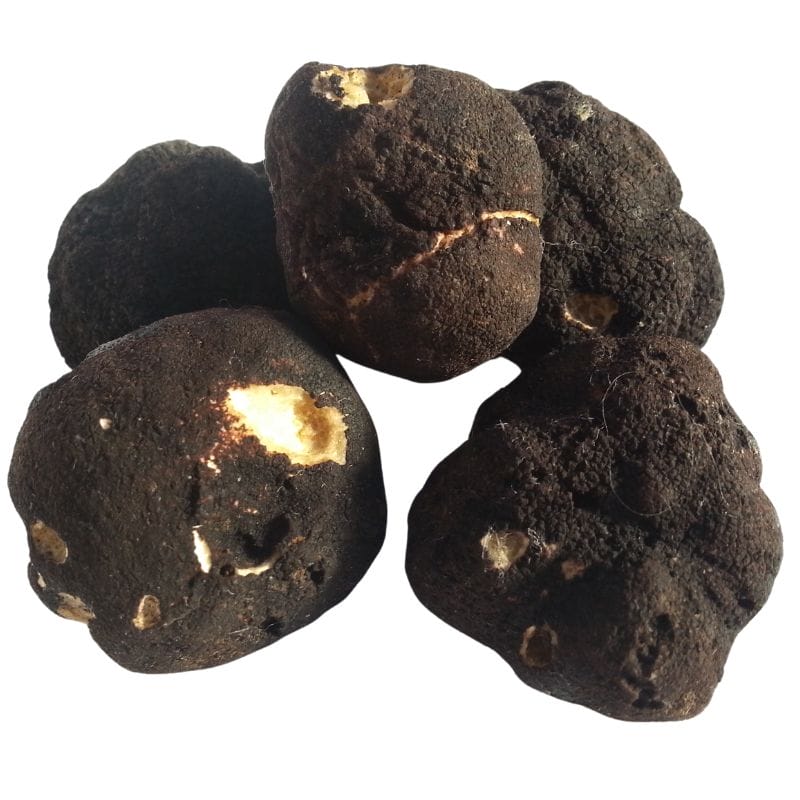
Leucangium carthusianum, also called the Oregon black truffle, grows in the Pacific Northwest and usually shows up around Douglas-fir trees. It’s a native species and one of the more well-known edible truffles from the region.
On the outside, it looks like a small lump of coal—dark black, kind of lumpy or warty, and sometimes slightly smoother in spots. They’re usually about the size of a golf ball, but they can be smaller or larger depending on the season.
Inside, the truffle is firm with a marbled pattern of gray and white veins running through it. When it’s fresh, it smells fruity, almost like pineapple, but the scent gets stronger and muskier as it ripens.
If you’re out looking for them, check in moist, shady forests with soft, loamy soil, especially where there’s a lot of moss or ferns. They grow just below the surface, so people often use trained dogs to help sniff out the ripe ones.
Compared to the Oregon white truffle, which is lighter in color and has a sharper, garlicky aroma, the black truffle has a deeper, more earthy smell. It’s also bigger and firmer than the southern U.S. truffles like Tuber lyonii, which tend to be smaller, paler, and grow around hardwoods like oaks and hickories.
Oregon Winter White Truffles (Tuber oregonense and Tuber gibbosum)
Oregon has two native white truffles that are starting to get more attention: the Oregon Winter White Truffle (Tuber oregonense) and the Oregon Spring White Truffle (Tuber gibbosum). They grow underground in forests and are prized for their strong, savory aroma.
From the outside, these truffles are small, roundish, and kind of bumpy, usually pale beige to light brown. Cut one open, and you’ll see a white interior that darkens with age, showing off a web of white veins when it’s fully mature.
The Winter White Truffle pops up from late fall into February, while the Spring White starts showing up around January and can last into June. They’re pretty similar, but the Winter variety is known for having a more powerful scent and flavor.
To find them, you’ll want to look in forests with younger Douglas-fir trees on the west side of the Cascades. Truffle hunters often check for loose soil or spots where animals have been scratching, which can be a sign there’s something below.
When fully ripe, both types give off a bold smell that’s often compared to garlic, cheese, or earthy spices. They’re usually served raw, shaved over dishes to add that truffle kick without losing any of the aroma.
Appalachian Truffle (Tuber canaliculatum)
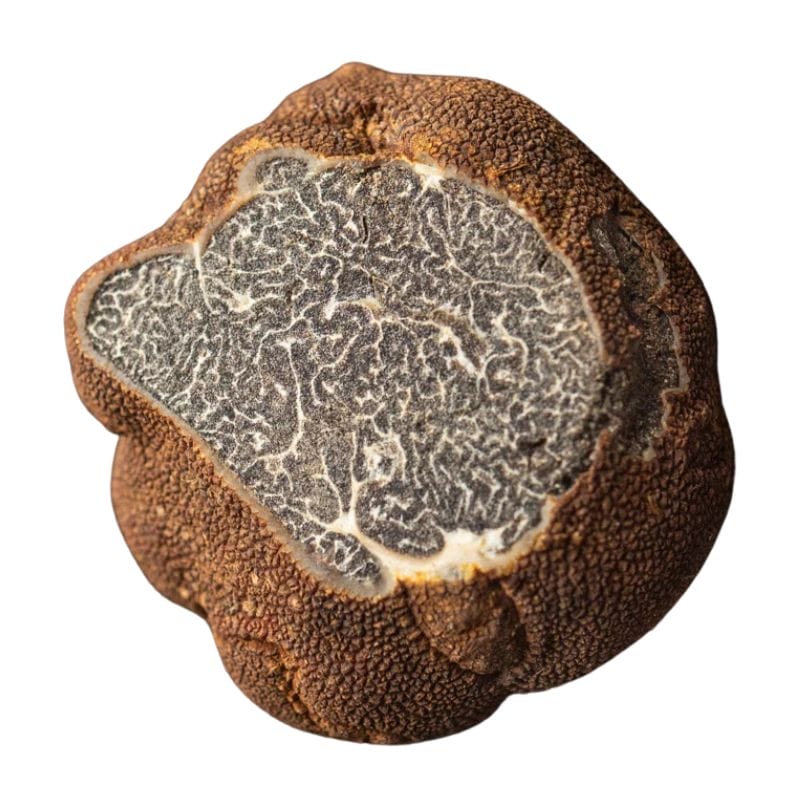
The Appalachian truffle, also known as Tuber canaliculatum, is a native North American truffle that’s slowly getting noticed. It’s about the size of a walnut and has a reddish-brown, bumpy outer surface that looks kind of like a rough, warty potato.
When you cut it open, the inside is firm and dark brown with thin white veins running through it like a marbled pattern. If it’s fully ripe, the smell is strong and earthy—some say it has a kind of nutty, funky aroma that stands out.
You can find these truffles in mixed hardwood forests, especially around oaks and pines, from late summer through fall. They grow underground, so look for spots where the soil is loose and animals like squirrels have been digging—sometimes that’s a good clue.
If you’re foraging, gently raking the top layer of soil near tree roots can help, but a trained dog or even a good nose makes it way easier. Once you know what to look for, the reddish color and bumpy skin are good signs you’ve found the right thing.
Compared to truffles like Tuber oregonense or Leucangium carthusianum, Tuber canaliculatum is more subtle in every way. Its smaller size and lighter scent mean you have to pay closer attention when foraging.
It’s also not as popular in the culinary world because it doesn’t pack the same punch in terms of flavor or aroma. Still, finding one can be rewarding, especially if you’re exploring different types of fungi in the area.
Desert Truffle (Terfezia and Tirmania spp.)
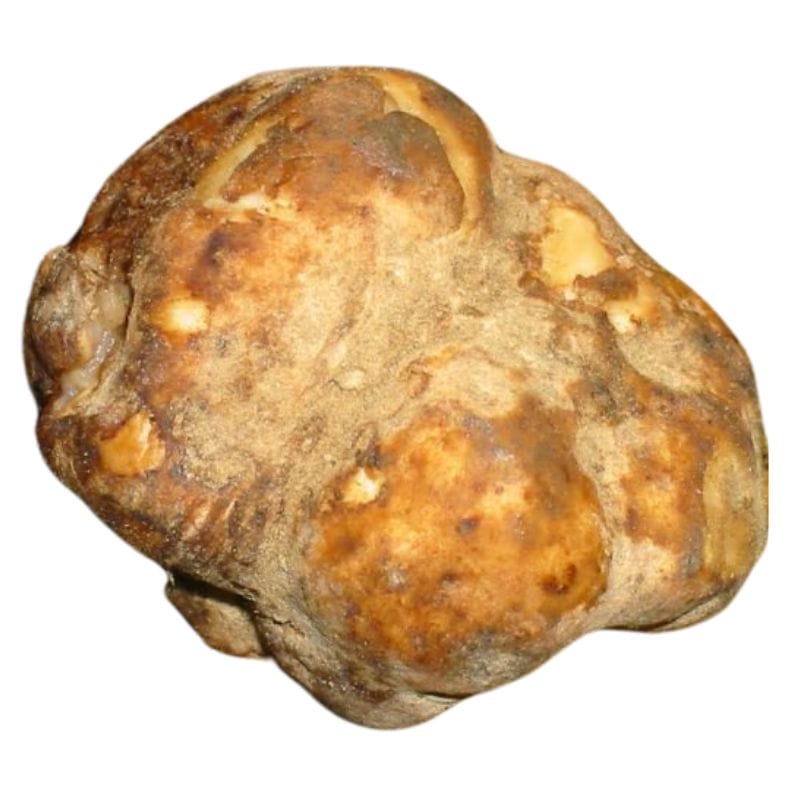
Terfezia and Tirmania are two types of truffles that are sometimes called desert truffles. These are a bit different from the truffles we usually think of, with their bold flavors and rich aromas.
These ones are a little more understated, but they’re fascinating in their own right. What makes them stand out is their ability to thrive in dry, harsh environments where you wouldn’t expect something so delicate to grow.
Unlike the earthy, intense aroma of black or white truffles, Terfezia and Tirmania truffles have a milder scent and flavor. They’re often described as nutty, with a hint of sweetness, but they lack the strong garlicky or musky notes you might associate with other truffles.
Their texture is also different—more firm and less oily than what you’d find with species like Tuber oregonense. They might not have the same culinary punch, but they’re still prized in traditional dishes, where their subtle flavors shine in simpler recipes.
When it comes to appearance, they’re easy to spot once you know what you’re looking for. They’re round to slightly irregular in shape, and their color can range from light beige to a reddish-brown, depending on the species.
The surface is usually smooth or slightly textured, without the rough, knobby look of a black truffle. Cut one open, and you’ll see a pale interior that’s often uniform in color, lacking the intricate veining you’d see in something like Leucangium carthusianum.
Pecan Truffle (Tuber lyonii)
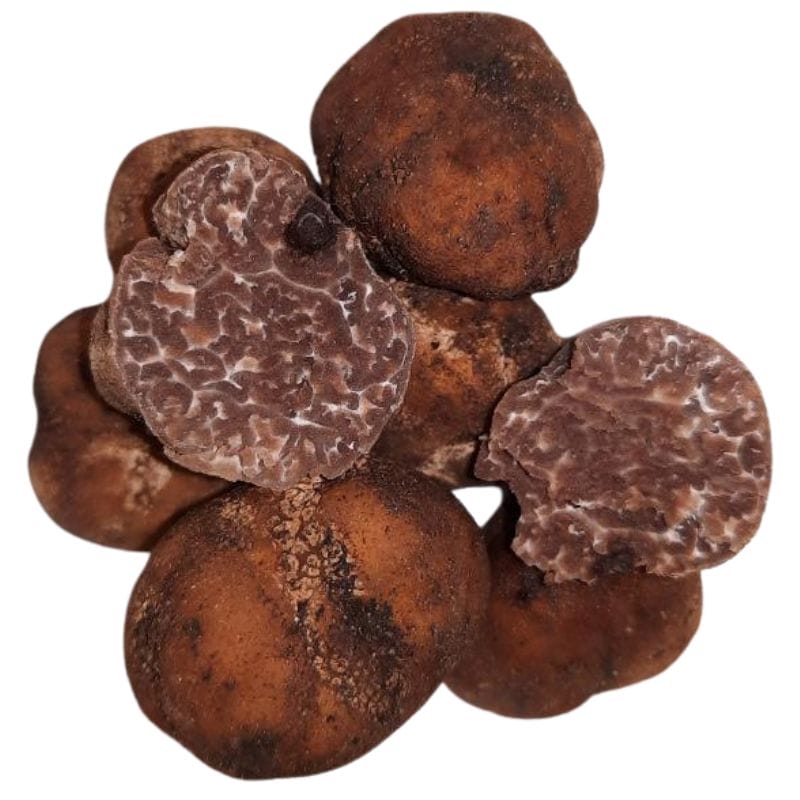
Tuber lyonii, also known as the pecan truffle, is a native North American truffle that grows underground near the roots of pecan trees. You’ll mostly find it in the southeastern U.S., especially in states like Texas, Georgia, and Mississippi.
On the outside, pecan truffles are round to lumpy and have a smooth, light brown skin that darkens as they age. They’re usually about the size of a marble or golf ball, and sometimes they even poke up slightly through the soil surface.
If you slice one open, the inside has a pretty marbled look—light tan streaks mixed with darker brown, almost like wood grain. The smell is earthy, nutty, and kind of warm, especially when they’re fully mature.
When you’re out looking for them, check under mature pecan trees or other hardwoods like oaks and hickories. Trained dogs can help sniff them out, but people sometimes spot them by looking for little cracks in the soil or raised areas near the tree’s base.
Compared to other U.S. truffles like the Oregon white truffle or the Appalachian black truffle, pecan truffles have a milder flavor and are more common in orchards. They’re a solid option in the kitchen—freshly sliced over pasta or mixed into butter—and they don’t come with the high price tag of their European cousins.
A Quick Reminder
Before we get into the specifics about where and how to find these plants and mushrooms, we want to be clear that before ingesting any wild plant or mushroom, it should be identified with 100% certainty as edible by someone qualified and experienced in mushroom and plant identification, such as a professional mycologist or an expert forager. Misidentification can lead to serious illness or death.
All plants and mushrooms have the potential to cause severe adverse reactions in certain individuals, even death. If you are consuming wild foragables, it is crucial to cook them thoroughly and properly and only eat a small portion to test for personal tolerance. Some people may have allergies or sensitivities to specific mushrooms and plants, even if they are considered safe for others.
The information provided in this article is for general informational and educational purposes only. Foraging involves inherent risks.
Truffle Lookalikes To Avoid
When you’re out hunting you also need to know about a few different fungi species that look very similar to the delicious truffles we’re after but are either inedible or not worth eating. Keep an eye out for:
Pine Truffles (Geopora cooperi)

Geopora cooperi is a fungus that can easily confuse someone new to truffle hunting. It’s sometimes called the pine truffle because it grows underground like a true truffle and often pops up near certain trees.
At first glance, it might seem like you’ve hit the jackpot, but this one is a false truffle, not something you’d want to eat or sell.
The easiest way to tell Geopora cooperi apart from real truffles is by looking closely at its structure. While true truffles have a smooth or slightly knobby exterior and a marbled interior, Geopora cooperi has a rougher, more irregular outer surface.
When it matures, it sometimes splits open, revealing a cup-like shape, which true truffles never do. Inside, it’s less dense and doesn’t have the intricate veining that makes real truffles so unique.
Another big difference is the smell. True truffles have a strong, rich aroma that’s earthy, sweet, or garlicky, depending on the species. Geopora cooperi, on the other hand, has a much weaker scent, and it’s not as pleasant or distinctive.
If you’re relying on aroma to identify your find, this one will give itself away pretty quickly. So, while it might look similar at first, a closer inspection will show it’s not the culinary treasure you’re hoping for.
Stinking Slime Truffle (Melanogaster ambiguus)
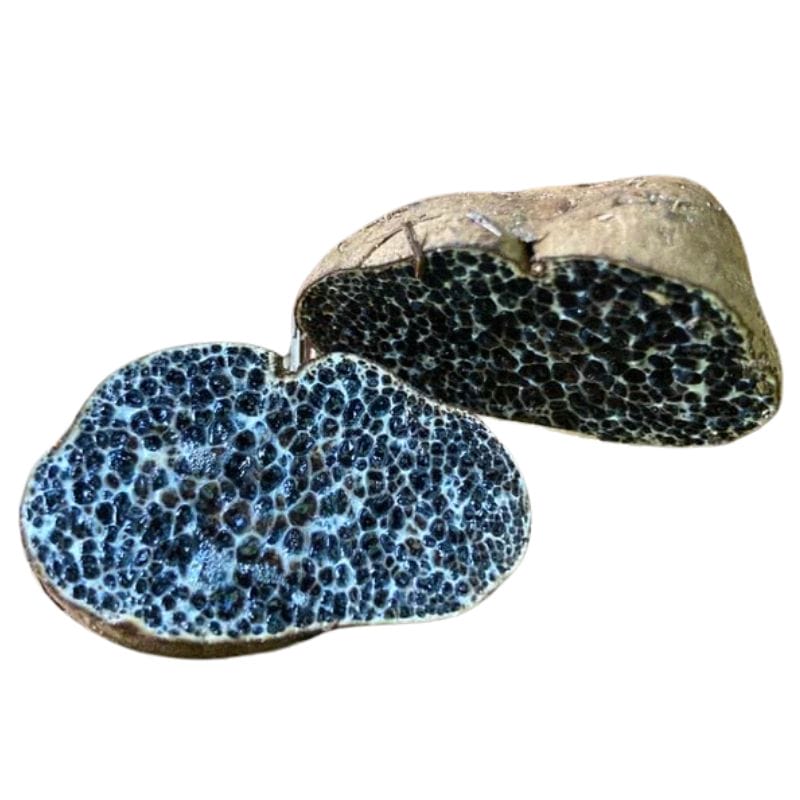
Melanogaster Ambiguus, because of their reddish-brown to dark brown exterior, might look like true truffles at first glance, but they’re quite different when you know what to look for.
The key difference is on the inside. When you cut open Melanogaster ambiguus, the interior is filled with flattened cells that have a shiny black gelatinous feel to them. Real truffles, on the other hand, have those beautiful marbled veins running through their flesh, almost like a web.
Another giveaway is the smell. While real truffles have a rich, earthy aroma that’s mouthwatering, Melanogaster ambiguus tends to have a much stronger, almost unpleasant odor—it’s not something you’d want to sprinkle on your pasta.
Earthballs (Scleroderma)
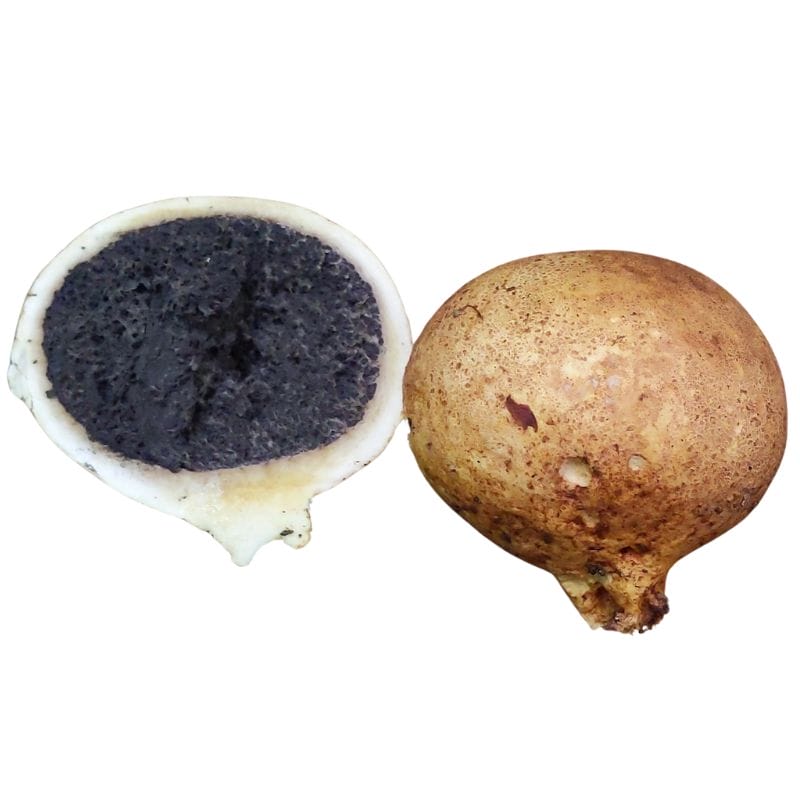
Scleroderma, commonly called earthballs, can easily fool someone who’s just starting out because they grow underground and have a round shape similar to truffles. But don’t be tricked—Scleroderma is not a true truffle, and it’s actually toxic, so it’s important to know how to tell the difference.
The first thing you’ll notice is the outer skin, which is thicker and tougher than that of most truffles. It can range in color from yellowish to dark brown, often with a rough or cracked texture.
If you cut it open, the difference becomes even clearer. While true truffles have a marbled interior with delicate white veins, Scleroderma starts out with a whitish inside that quickly darkens as it matures, turning black or purple with no marbling. It’s dense and solid, almost like charcoal in the later stages.
Another big giveaway is the smell. True truffles have a rich, earthy aroma that makes them so prized, while Scleroderma has little to no pleasant scent—some even describe it as musty or unpleasant.
Deer Truffles (Elaphomyces)
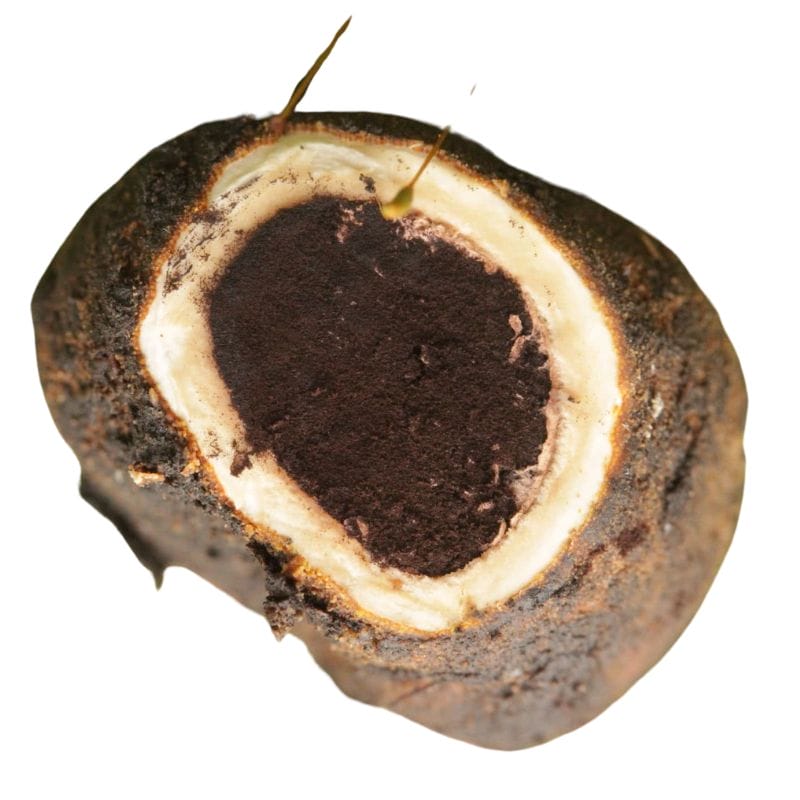
Elaphomyces, also known as deer truffles, look like true truffles at first glance, but they’re a whole different story. They’re called deer truffles because wildlife, especially deer and rodents, love to eat them. For us humans, though, they’re not edible—and definitely not what you want to mistake for a prized truffle.
Here’s how you can tell Elaphomyces apart from the real thing. First, they have a tough, warty outer surface that can range from pale tan to black, depending on the species and their age.
When you cut them open, the inside is solid and sometimes speckled or marbled, but not in the delicate, vein-like pattern you’d see in true truffles.
Their smell is also a big giveaway. Instead of the rich, earthy aroma of an edible truffle, Elaphomyces either has little scent or an odor that’s earthy but not particularly appealing.
Another thing to know is that Elaphomyces often grows deeper in the soil than true truffles, and they tend to have a harder, woodier texture.
Best Practices For Finding Truffles
Truffle hunting can be a rewarding adventure if you know the right tips and tricks. Here’s what you should keep in mind to improve your chances of finding these underground treasures:
Wait 10 to 14 Days After Heavy Rain
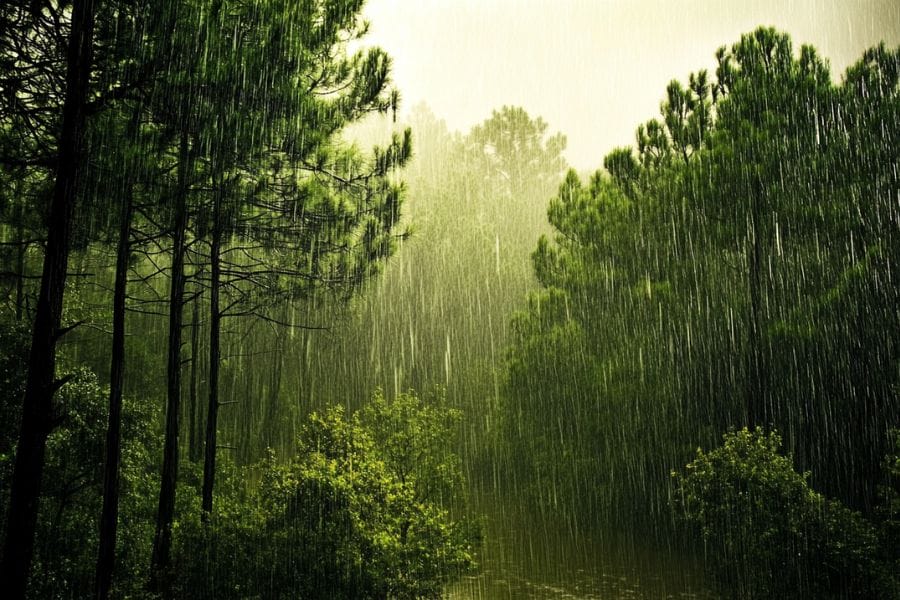
After a heavy rain, it’s best to wait about 10 to 14 days before heading out. This gives the truffles time to mature and release their signature aroma, making it easier for you (and your dog) to sniff them out. Rain helps truffles grow, but they don’t start giving off their scent right away.
As the soil warms up, the truffles get more aromatic, and the ground becomes looser, which makes digging easier without disturbing the environment too much. The timing is perfect to find truffles at their best—both in quality and in how easy they are to locate.
Find the Right Trees

Truffles don’t grow just anywhere—they have a special relationship with certain trees. You won’t find them under just any tree, so knowing which ones to look for can make all the difference. Some of the best trees to look out for are:
- Pines
- Douglas-firs
- Oaks
- Hazelnuts
- Cypresses
- Willows
For example, if you’re looking for Oregon white truffles, keep an eye out for Douglas-fir trees. California black truffles, on the other hand, are often found near oaks and hazelnuts. The soil around these trees also needs to be slightly alkaline, so it helps to know what kind of ground you’re walking on as well.
Watch for Wildlife Activity
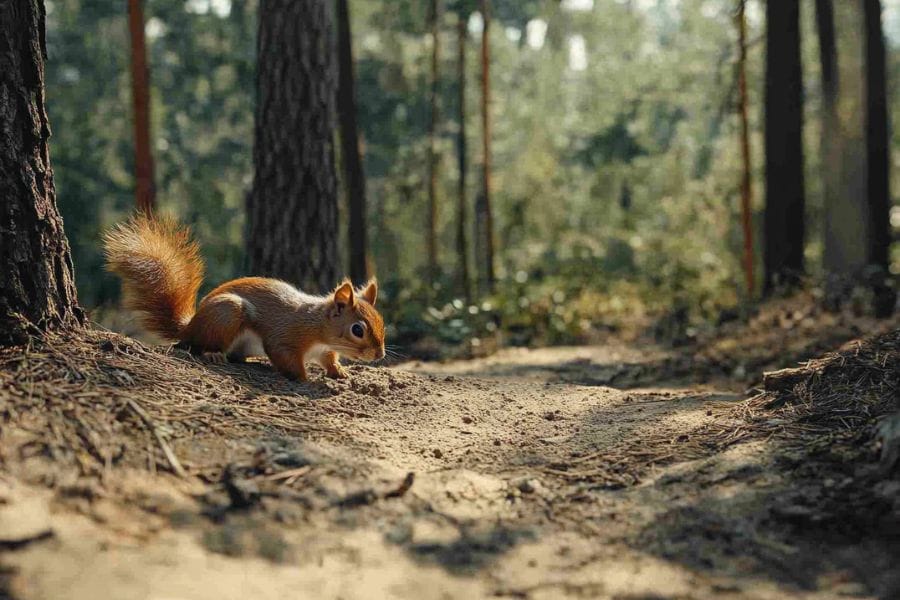
Animals like squirrels and chipmunks often help spread truffle spores, and sometimes their digging can lead you straight to truffles. While you won’t always find truffles in every pit animals dig (they also look for things like acorns or bulbs), fresh digs are a good clue. The more recent the pit, the better chance it has of leading to truffles.
Even though animals are a part of the truffle cycle, most hunters prefer using dogs to find the real treasure underground. Dogs have an incredible nose for truffles and can pinpoint their location much more reliably than any squirrel or chipmunk.
Get a Little Help from a Truffle-Hunting Dog
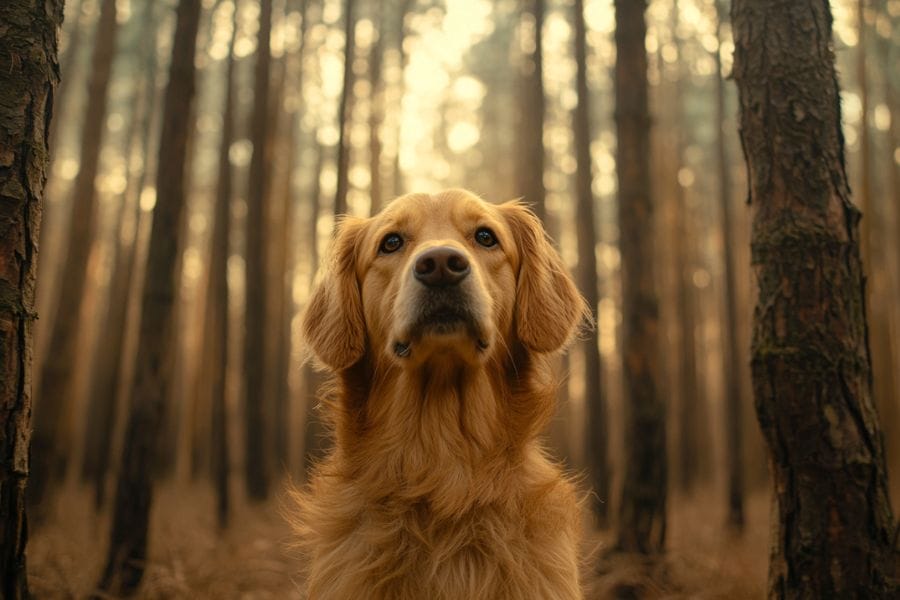
If you’re serious about truffle hunting, a trained dog can make your life a whole lot easier. Their sense of smell is extraordinary, and they’re trained to find mature truffles buried beneath the surface. Many truffle hunters swear by their dogs, and for good reason—they’re much more accurate than humans when it comes to sniffing out truffles.
If you don’t already have a trained dog, you can connect with local foraging groups or specialized trainers who offer truffle-hunting services. Some places even host events where you can see experienced handlers with their dogs in action. And if you’re feeling adventurous, you can train your own dog using truffle-scent kits and practice in a controlled space before hitting the woods.
Before you head out
Before embarking on any foraging activities, it is essential to understand and follow local laws and guidelines. Always confirm that you have permission to access any land and obtain permission from landowners if you are foraging on private property. Trespassing or foraging without permission is illegal and disrespectful.
For public lands, familiarize yourself with the foraging regulations, as some areas may restrict or prohibit the collection of mushrooms or other wild foods. These regulations and laws are frequently changing so always verify them before heading out to hunt. What we have listed below may be out of date and inaccurate as a result.
Where You Can Find Truffles Around The State
Now we’re going to go over five of the best locations for finding truffles. We’ll go a bit in-depth here and then provide a much longer list of other spots to try.
Pisgah National Forest
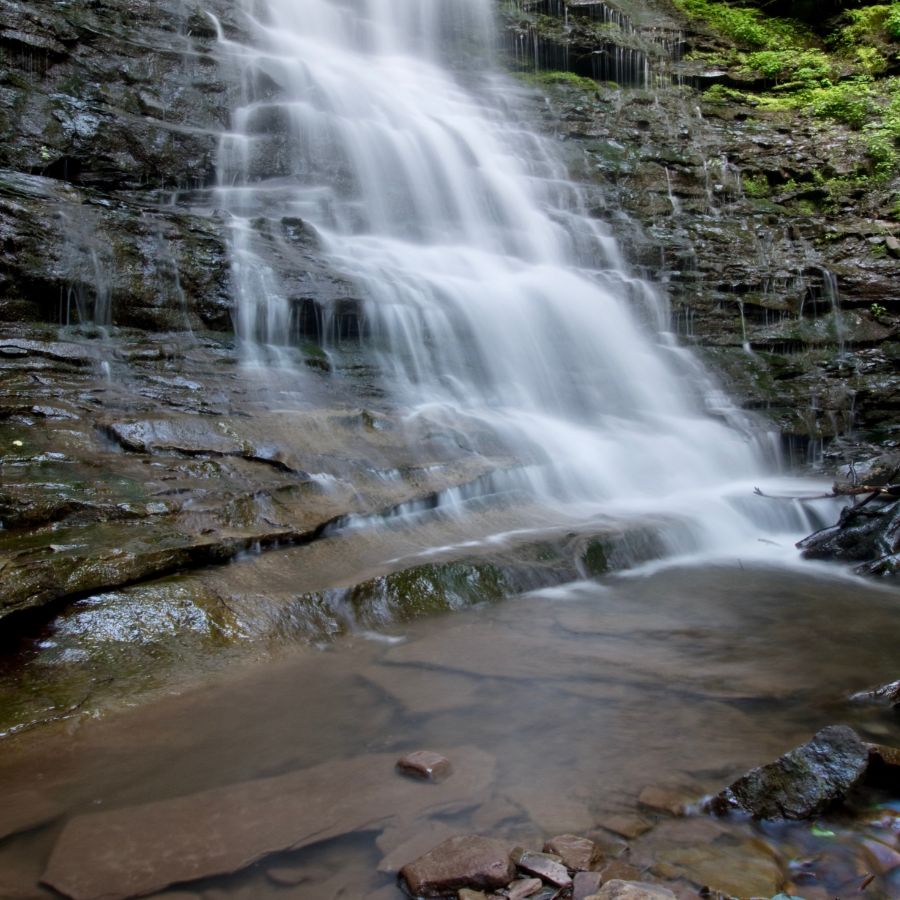
Pisgah National Forest is a stunning woodland area in western North Carolina. It covers more than 500,000 acres with lush forests and rolling hills.
The forest is home to many hardwood trees like oak and hickory that form special relationships with truffles underground. The cool, damp climate in Pisgah creates perfect conditions for truffle growth.
Look for areas with mature oak trees, especially in the Davidson River area, where the soil is rich and moist. Truffles tend to grow near tree roots in the top layer of soil.
The Bent Creek area in the forest also has good potential for truffle hunting with its mix of hardwoods and well-draining soil. Remember that patience is key as truffles are often camouflaged by surrounding soil and debris.
Uwharrie National Forest
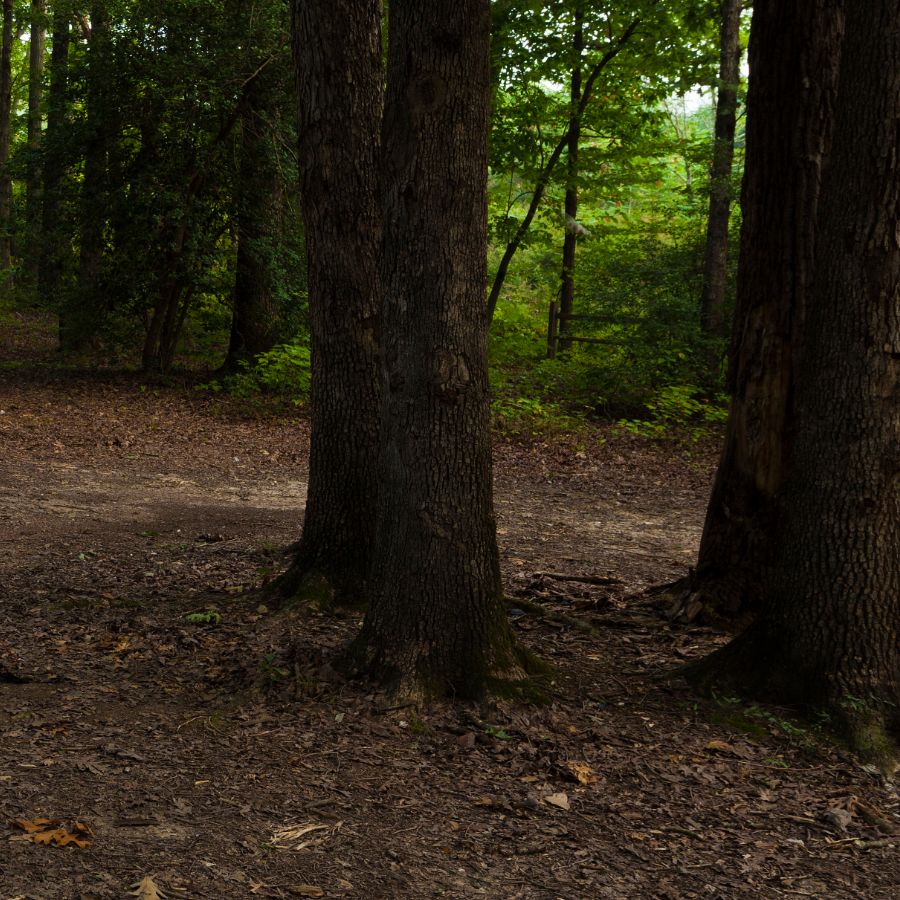
Uwharrie National Forest spans across several counties in central North Carolina. This ancient forest has some of the oldest mountains in North America.
The weathered soil here is particularly good for certain truffle species. Uwharrie features a diverse mix of tree species that support underground fungal networks.
Focus your search in areas with old-growth oaks, especially along Badin Lake’s shoreline, where calcium-rich soils support truffle development. The forest floor here has the perfect balance of moisture without being too wet.
Another promising area is around Morris Mountain, where the soil composition seems to favor truffle growth. The forest’s history of minimal disturbance in some areas has allowed complex fungal comunities to establish.
Croatan National Forest
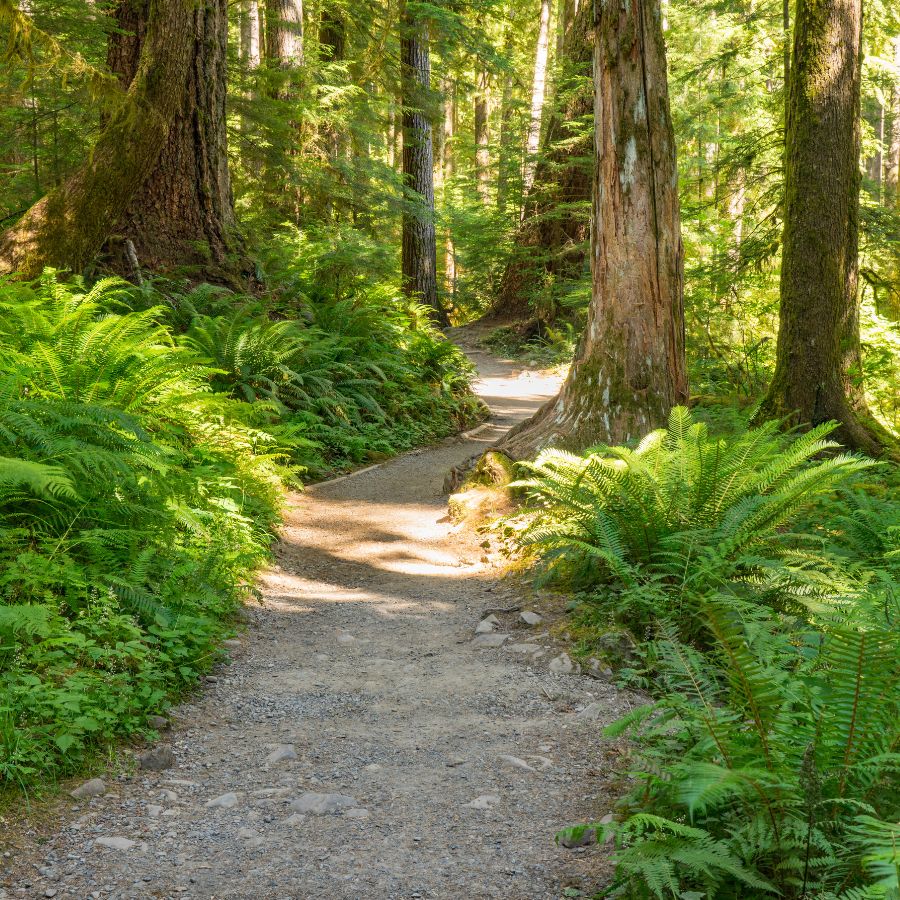
Croatan National Forest is located in eastern North Carolina near the coast. This unique forest ecosystem combines maritime influences with inland forest habitats.
The forest contains a fascinating mix of pine forests, saltwater marshes, and pocosins. This diversity creates numerous ecological niches where different truffle species can grow.
Focus your search in the areas around the Neuse River where hardwood trees grow in relatively high ground. The slightly alkaline soils in these areas create good conditions for truffle development.
You might also have success in the pine forests near the Patsy Pond Nature Trail where mycorrhizal relationships are well-established. Local wildlife like wild boars can sometimes lead you to productive truffle areas since they naturally forage for these underground delicacies.
Nantahala National Forest
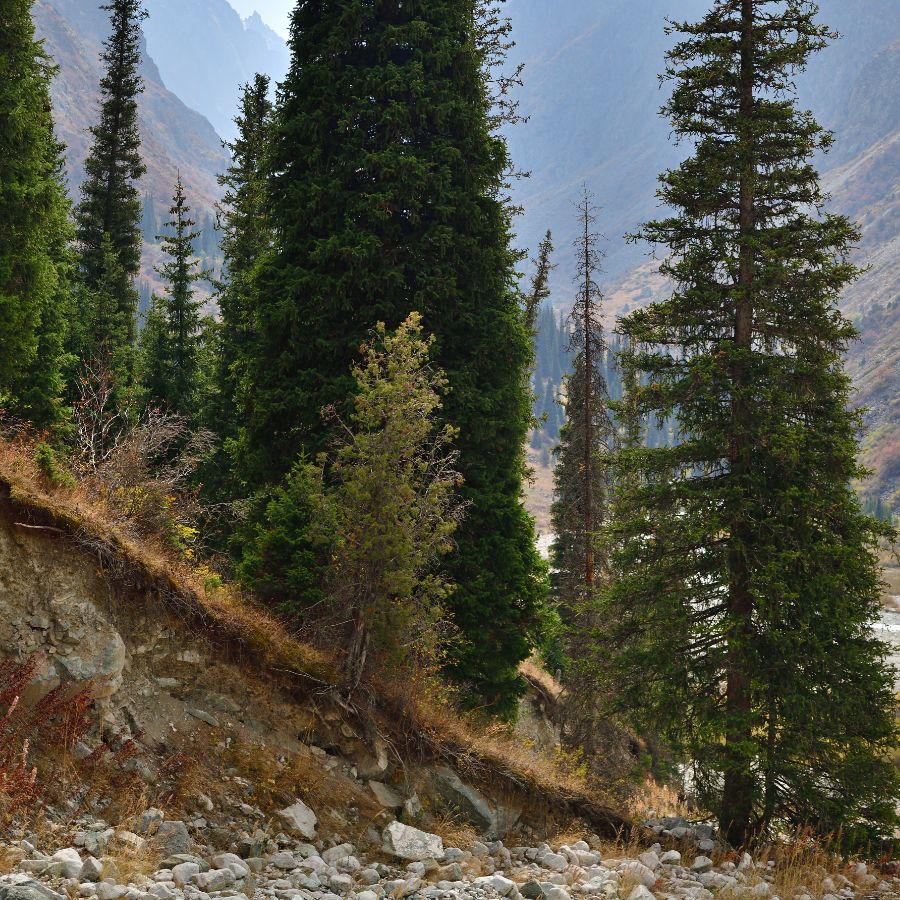
Nantahala National Forest is the largest national forest in North Carolina. The name comes from a Cherokee word meaning “land of the noonday sun.”
The high elevation and abundant rainfall create ideal moisture conditions for many truffle species. This massive forest covers over 500,000 acres of mountainous terrain in the southwestern part of the state.
Look for truffles in the Joyce Kilmer Memorial Forest section, where old-growth forests provide established mycorrhizal networks. The Standing Indian Basin area is another promising location with its mix of hardwoods and rich, undisturbed soil.
Truffles often grow along the edges of clearings where trees receive good sunlight, but the ground stays shaded and moist. Nantahala’s remote nature means many areas see little human traffic and remain undisturbed.
DuPont State Recreational Forest
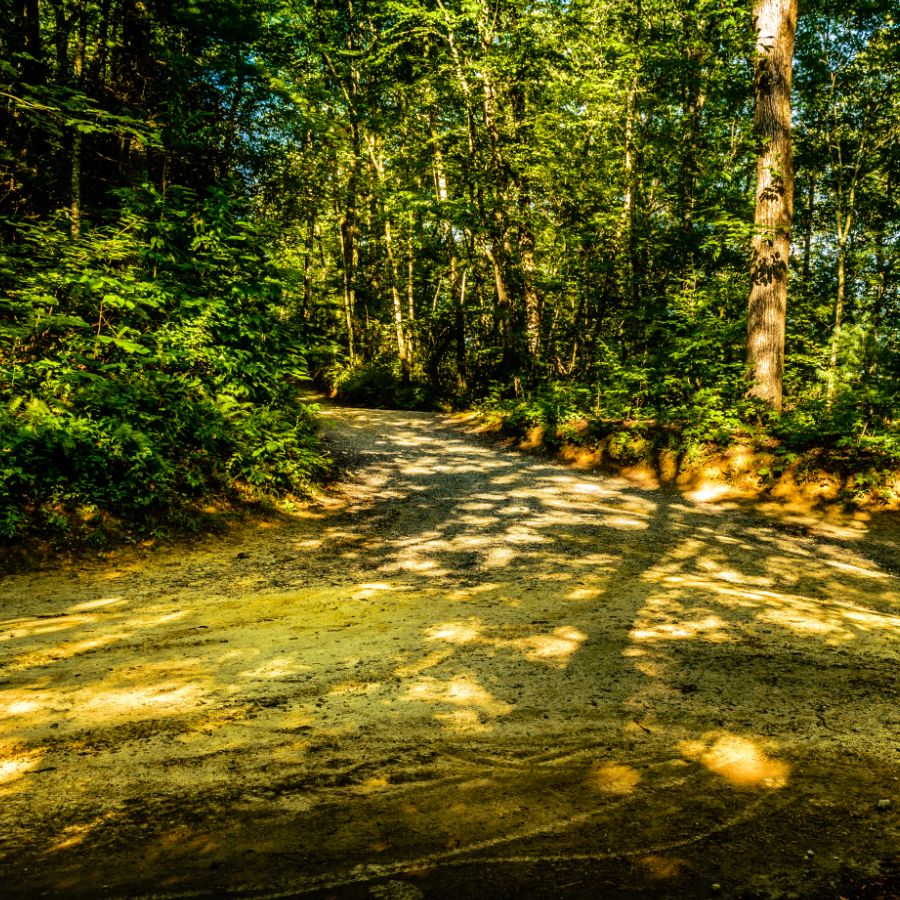
DuPont State Recreational Forest sits between Hendersonville and Brevard in western North Carolina. This 10,000-acre forest is famous for its beautiful waterfalls and scenic hiking trails.
The forest has a diverse mix of habitats including hardwood forests, pine stands, and unique geological features. The varying elevation and soil types create many different microenvironments where truffles can grow.
The Cedar Mountain area of the forest has particularly promising soil conditions with the right acidity and drainage for truffles. Look for truffles near stands of oak and beech trees, particularly in areas with northern exposure where the soil stays consistently moist.
Another good spot is along the ridges near Lake Julia where mature hardwoods have established strong mycorrhizal relationships. The forest’s popularity with hikers means you should search in less-trafficked areas away from main trails.
Other Great Locations For Truffles
| Mountains Region | What’s allowed & why it’s good truffle ground |
|---|---|
| Bent Creek Experimental Forest (Pisgah NF) | Mixed cove hardwoods beside Asheville; USFS personal-use rule covers hand-picking ground truffles. |
| Cheoah Ranger District – Nantahala NF | Damp ravines below Robbinsville yield summer T. lyonii; gather ≤ 1 gallon/day. |
| DuPont State Recreational Forest | Forest rangers host annual mushroom hikes, and the free day-permit lets you keep culinary finds. |
| Grandfather Ranger District – Pisgah NF | Linville Gorge & Wilson Creek head-waters fruit black truffles after storms; USFS rule applies. |
| Headwaters State Forest | Remote coves on the SC line; NCFS permit covers personal truffle forays. |
| Holmes Educational State Forest | Moist fern-filled draws near Hendersonville; pocket permit available at the kiosk. |
| Linville Gorge Wilderness (Pisgah NF) | Rocky oak benches hide aromatic browns; USFS “small-amount” rule okays take-home harvest. |
| Nantahala Ranger District – Nantahala NF | Popular Standing Indian & Wayah Bald loops yield fall truffles; personal gathering allowed. |
| Pisgah Ranger District – Pisgah NF | Bent Creek to Shining Rock gives reliable flushes; USFS rule covers baskets & knives only. |
| Shining Rock Wilderness (Pisgah NF) | Acidic spruce–fir pockets host black truffles midsummer; treat as any Pisgah NF area. |
| South Mountains Game Land | Chestnut-oak ridges in Burke Co.; forage with a Game-Lands permit outside hunt dates. |
| Tuttle Educational State Forest | Beech-oak bluffs above the Yadkin give spring truffles; free NCFS permit required. |
| Tusquitee Ranger District – Nantahala NF | Moist hollows near Murphy produce white truffles after rains; ≤ 1 gallon rule. |
| Wayah Ranger District – Nantahala NF | Rich cove forests north of Franklin; same USFS allowance. |
| Wilson Creek Wild & Scenic (Pisgah NF) | Flood-scoured terraces hide fragrant truffles each fall; USFS personal-use limit applies. |
| Piedmont Region | What’s allowed & why it’s good truffle ground |
|---|---|
| Badin Lake Rec Area – Uwharrie NF | Oak–pine sandhills fruit summer truffles; USFS rule okays family harvesting. |
| Birkhead Mtns Wilderness (Uwharrie NF) | Thin quartzite soils spark early-season truffles; hand-tools only. |
| Butner-Falls of Neuse Game Land | Shaded coves near Falls Lake loaded with pecan truffles; access with Game-Lands pass. |
| Chatham Game Land | Deep River terraces yield summer truffles; permit recommended. |
| Jordan Game Land | Mixed oak ridges around the lake produce reliable finds; Game-Lands rules apply. |
| Jordan Lake Educational State Forest | Sand-pine slopes south of Apex; NCFS permit covers fungi take-home. |
| Linwood Game Land | Yadkin bottomlands harbor spring truffles; forage outside waterfowl impounds. |
| Mayo Game Land | Hickory ridges near Roxboro flush with T. lyonii in July; wear orange in season. |
| Pee Dee River Game Land | Alluvial islands reveal white truffles after high water; Game-Lands permit needed. |
| Sandhills Game Land | Longleaf-wiregrass savannas host pine-loving truffles post-burn; permit covers take. |
| Uwharrie National Forest (Ranger District) | 51,000 acres of ancient monadnocks; USFS personal-use rule okays up to 1 gal/day. |
| Vance Game Land | Moist hardwood bottoms near Henderson offer fall truffles; access with WRC pass. |
| Coastal Plain Region | What’s allowed & why it’s good truffle ground |
|---|---|
| Angola Bay Game Land | Pocosin edges reveal smooth brown truffles after heavy rains; Game-Lands permit. |
| Bladen Lakes State Forest | 33,000-acre longleaf flatwoods; NCFS permit authorises hand-gathering fungi. |
| Bullard & Branch Game Land | Live-oak hummocks near the Cape Fear grow white truffles in sandy loam. |
| Cape Fear River Wetlands Game Land | Levee woods fruit spring truffles; Game-Lands rules apply. |
| Cedar Point Recreation Area (Croatan NF) | Easy boardwalks over pine savanna with summer truffles; covered by USFS limit. |
| Croatan National Forest | 160,000-acre coastal forest; USFS okays ≤ 1 gallon/day anywhere outside research plots. |
| Goose Creek Game Land | Blackwater floodplains nurture aromatic truffles; WRC permit gives access. |
| Holly Shelter Game Land | Well-drained pinelands famed among Wilmington foragers; harvest for home meals. |
| Juniper Creek Game Land | Sand-ridge longleaf stands fruit pine-associated truffles after summer storms. |
| Neuse River Recreation Area (Croatan NF) | Moist mixed hardwood islands along the Neuse spillway host truffles; USFS rule applies. |
| North River Game Land | Brackish hammocks hide salt-tolerant truffles; Game-Lands permit covers picking. |
| Suggs Mill Pond Game Land | Carolina-bay rims yield fragrant truffles under loblolly; permit required. |
When The Best Time Of The Year Is To Find Truffles
Truffle hunting in North Carolina works best during the cooler months. Late fall through winter offers the most success for finding mature truffles. November to February is when most local varieties reach their peak.
The cold weather helps truffles develop their strong flavor and scent. Rain also plays a big role in truffle growth. Look for periods after steady rainfall when the ground is moist but not soggy.
Some early truffle varieties appear in October. Late-season truffles can sometimes be found into March. Always check weather patterns before planning your truffle hunt.
One Final Disclaimer
The information provided in this article is for general informational and educational purposes only. Foraging for wild plants and mushrooms involves inherent risks. Some wild plants and mushrooms are toxic and can be easily mistaken for edible varieties.
Before ingesting anything, it should be identified with 100% certainty as edible by someone qualified and experienced in mushroom and plant identification, such as a professional mycologist or an expert forager. Misidentification can lead to serious illness or death.
All mushrooms and plants have the potential to cause severe adverse reactions in certain individuals, even death. If you are consuming foraged items, it is crucial to cook them thoroughly and properly and only eat a small portion to test for personal tolerance. Some people may have allergies or sensitivities to specific mushrooms and plants, even if they are considered safe for others.
Foraged items should always be fully cooked with proper instructions to ensure they are safe to eat. Many wild mushrooms and plants contain toxins and compounds that can be harmful if ingested.

